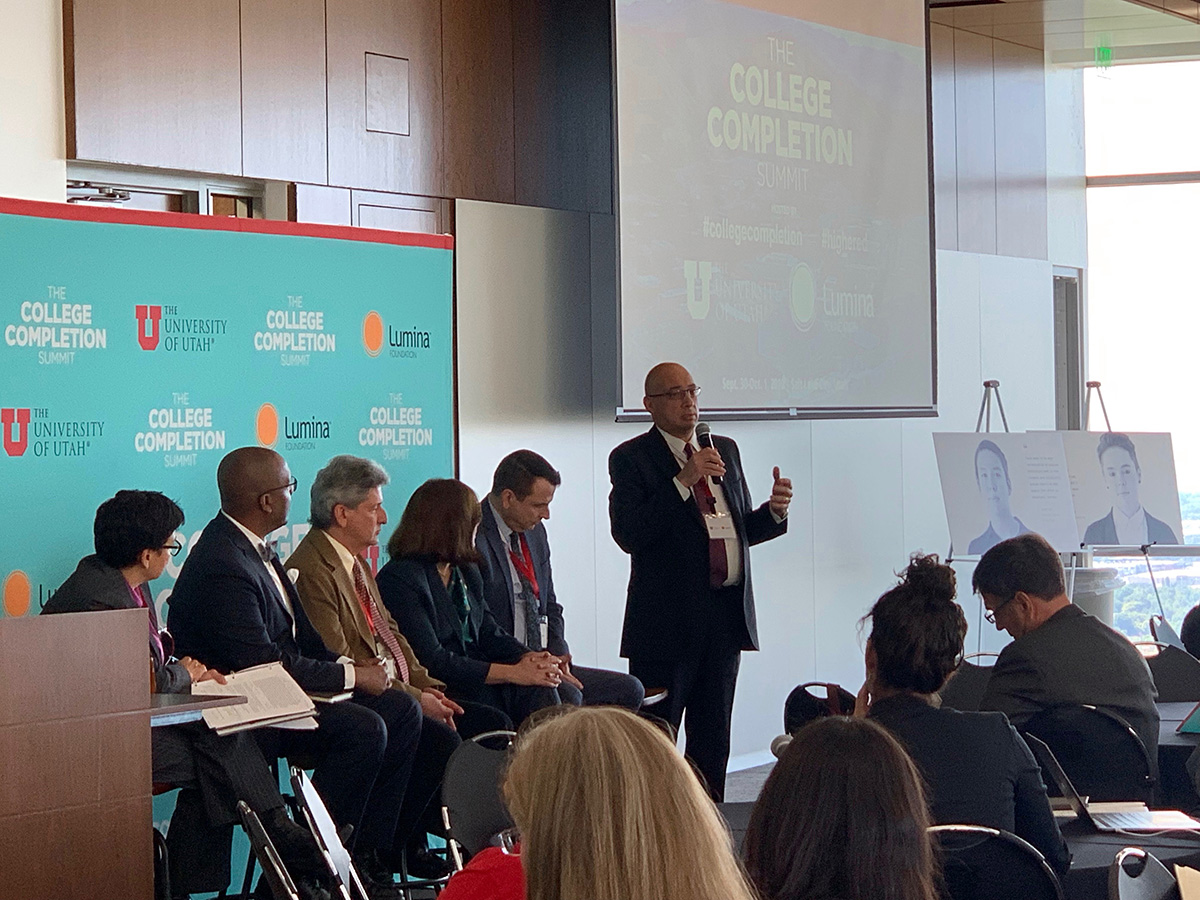Editor’s note: This is one in a series of stories about The College Completion Summit held at the University of Utah on Sept. 30-Oct. 1, 2019. The title of this panel was “Leveling the Playing Field: Achieving Equity in Completion.” Panel members included: David Lassner, president of the University of Hawai’i; Monica Brockmeyer, associate provost, Wayne State University; Timothy Renick, senior vice president for Student Success, Georgia State University; and Nikos Varelas, vice provost for Undergraduate Affairs and Academic Programs, University of Illinois at Chicago. The moderator was Mary Ann Villarreal, vice president for Equity, Diversity and Inclusion at the University of Utah. The panel discussion was preceded by a keynote address given by Dhanfu Elston, vice president for strategy at Complete College of America.
Wayne State University once made headlines for all the wrong reasons: enrollment was down, only 26% of students were graduating, school budgets were being cut, and the City of Detroit was headed into bankruptcy. But dismal statistics at schools like Wayne State are turning around, reported panel members at the College Completion Summit hosted by the University of Utah and Lumina Foundation.
At George State University in Atlanta, where the student body is now 74% non-white, graduation rates are rising and the school graduates more African-American students than any other college or university in the United States, reported Timothy Renick, the school’s senior vice president for student success, speaking on the panel “Leveling the Playing Field: Achieving Equity in Completion.”
Still, nationally, that playing field is still uneven, said keynote speaker Dhanfu Elston, vice president for strategy at Complete College America, based in Indianapolis. Elston travels the country talking about college completion rates and strategies.
“It’s always a great conversation when you talk about national data. Everyone is like, ‘Oh, that’s a challenge, we need to work on that,’” Elston said. “And then you say, ‘and here’s your state,’ and they say, ‘Oh, yes, problematic.’ And you go, ‘and here’s your institution,’ and they’re like ‘Oh, that can’t be right. That data can’t be right.”
The data shows, he said, that more students nationwide are enrolling in college part time, that these students often don’t graduate and that “African-Americans and Hispanics are underrepresented in the fastest-growing, highest-paying occupations—STEM, health and business.”
Among the strategies that have proved successful at Georgia State University: Assessing the “800 risk factors” that apply across-the-board for all students. Over the past year, alerts promoted by that data have led to 102,000 one-on-one meetings between advising staff and students. “What we’ve seen is that it’s disproportionately benefited the students who were served the least well under the old bureaucracy, where these kinds of proactive interventions simply didn’t exist,” Renick said. “So this institution that was once a poster child nationally for equity gaps is now an institution where race, ethnicity and income level do not predict which students are going to be successful.”
At Wayne State, graduation rates have jumped 22% in the past seven years, including for African-Americans, Latinx, first-generation and Pell Grant students, said Monica Brockmeyer, associate provost for student success.
At the University of Illinois at Chicago, retention has increased by 20 percentage points, said Nikos Varelas, vice provost for undergraduate affairs. Two strategies drove that progress: “transition coaching” in local high schools and encouraging students to stay in school year-round by giving them a buy-one-get-one-free deal on summer tuition.
At the University of Hawai’i, which has a large population of indigenous, Filipino and Pacific Islander students, the school has closed gaps in college attendance and graduation rates, said President David Lassner. “We put you into a four-year path and you have to opt out, not in.”
“We can’t just sit inside our institutions and bemoan who shows up at our doors and how unprepared they are,” Lassner said. Gaps in learning, and other challenges, come with the students. But colleges and universities, he said, “are institutions that can make it so that their children don’t face the same challenges.”
